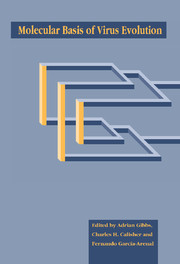Book contents
- Frontmatter
- Contents
- List of contributors
- Editors' preface
- Conference participants
- 1 Introduction and guide
- Part I The impact of viral diseases
- Part II Origins of viruses and their genes
- Part III Sources of virus variation
- Part IV Molecular interactions of viruses and their hosts
- Part V Viruses, hosts and populations
- Part VI Case studies of viral taxa; their systematics and evolution
- 18 Evolution of poxviruses and African swine fever virus
- 19 Molecular systematics of the flaviviruses and their relatives
- 20 Herpesviridae
- 21 Aphthovirus evolution
- 22 Evolution of the Bunyaviridae
- 23 Evolution of the tobamoviruses
- 24 The luteovirus supergroup: rampant recombination and persistent partnerships
- 25 The evolution of the Reoviridae
- 26 Genetic variation and evolution of satellite viruses and satellite RNAs
- 27 Molecular evolution of the retroid family
- 28 Adaptation of members of the Orthomyxoviridae family to transmission by ticks Patricia
- 29 The Order Mononegavirales: evolutionary relationships and mechanisms of variation
- 30 The molecular evolution of the human immunodeficiency viruses
- 31 Molecular evolution of papillomaviruses
- 32 Molecular systematics of the Potyviridae, the largest plant virus family
- 33 Evolution of alphaviruses
- 34 Evolution of influenza viruses: rapid evolution and stasis
- Part VII Techniques for viral systematics
- Index
28 - Adaptation of members of the Orthomyxoviridae family to transmission by ticks Patricia
Published online by Cambridge University Press: 04 May 2010
- Frontmatter
- Contents
- List of contributors
- Editors' preface
- Conference participants
- 1 Introduction and guide
- Part I The impact of viral diseases
- Part II Origins of viruses and their genes
- Part III Sources of virus variation
- Part IV Molecular interactions of viruses and their hosts
- Part V Viruses, hosts and populations
- Part VI Case studies of viral taxa; their systematics and evolution
- 18 Evolution of poxviruses and African swine fever virus
- 19 Molecular systematics of the flaviviruses and their relatives
- 20 Herpesviridae
- 21 Aphthovirus evolution
- 22 Evolution of the Bunyaviridae
- 23 Evolution of the tobamoviruses
- 24 The luteovirus supergroup: rampant recombination and persistent partnerships
- 25 The evolution of the Reoviridae
- 26 Genetic variation and evolution of satellite viruses and satellite RNAs
- 27 Molecular evolution of the retroid family
- 28 Adaptation of members of the Orthomyxoviridae family to transmission by ticks Patricia
- 29 The Order Mononegavirales: evolutionary relationships and mechanisms of variation
- 30 The molecular evolution of the human immunodeficiency viruses
- 31 Molecular evolution of papillomaviruses
- 32 Molecular systematics of the Potyviridae, the largest plant virus family
- 33 Evolution of alphaviruses
- 34 Evolution of influenza viruses: rapid evolution and stasis
- Part VII Techniques for viral systematics
- Index
Summary
Introduction
The influenza viruses of the Orthomyxoviridae family totally depend on higher vertebrates as hosts, and are transmitted by a respiratory or a faecal-oral route. In contrast, two new members of the family, Thogoto (THO) and Dhori (DHO) viruses, here called the orthoacarivirus group, replicate in both vertebrate and tick cells, and are transmitted by tick bite. This chapter compares orthoacariviruses with orthomyxoviruses (influenza viruses), and speculates on their evolutionary origins.
Natural history of Thogoto and Dhori viruses
The first reported isolation of THO virus was from a pool of ticks removed from cattle in Thogoto forest near Nairobi, Kenya, in 1960 (Haig, Woodall & Danskin, 1965). To date, the virus has been isolated from ixodid tick species collected in several countries extending across central Africa, and in Egypt, Iran, Sicily, and Portugal (Davies, Jones & Nuttall, 1986). Dhori virus was first isolated in 1971 from ticks removed from camels in north-west India (Anderson & Casals, 1973). Subsequent isolations have been made from ticks in the former USSR, Portugal, and Egypt (Jones et al., 1989). Experimental studies confirmed that both THO and DHO viruses are true arboviruses (Davies et ai, 1986; Jones et al., 1989) in that uninfected ticks become infected as they feed on THO or DHO virus-infected vertebrate hosts; the viruses replicate in the ticks, and are then transmitted by tick bite when the infected ticks take their next bloodmeal.
Both THO and DHO viruses have a wide vertebrate host range (Table 28.1).
- Type
- Chapter
- Information
- Molecular Basis of Virus Evolution , pp. 416 - 425Publisher: Cambridge University PressPrint publication year: 1995
- 16
- Cited by



